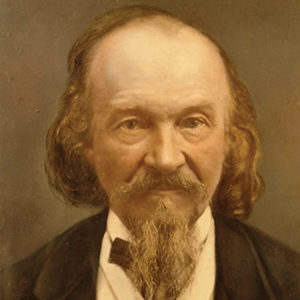 William Downing Evans (1811 – 1897)
William Downing Evans (1811 – 1897)
Whilst Civil War raged in America, the small mining towns of South Wales also faced conflicts of their own. Although these were battles without guns, armies and mass bloodshed, they were, nonetheless, struggles which pierced the hearts of men and women. Amidst all of this, William Downing Evans, the son of a humble lime burner, served his part as best he could: with poetry, music, painting and the unshaking voice of a man determined to see reform and improved conditions for his fellow people.
He was born in Caerleon, close to the Welsh town of Newport. The region was, like many others at the time, expanding quickly thanks to the industrial revolution taking place. However, the race for industrial success also brought appalling circumstances to local people. Both working and living conditions were becoming increasingly crowded and unsanitary, and William Downing Evans himself suffered deep unhappiness following the deaths of numerous relatives and friends due to ill health.
His activism led him, in 1845, to present a portfolio of evidence to the authorities, showing the real needs for a fresh look at the public health system and the overcrowded conditions of such now-industrialised towns.
Musical Style and Influences
Contents
Throughout all of this, he maintained his love of various art forms. He was able to speak and write Welsh to a very high standard, and often (when writing in English) adopted the pen-name Leon: likely a reference to the name of his birth town but also one considered somewhat ‘bardic’ in Great Britain at the time. His poems were often propaganda for the activist’s voice, and his song “A Cypress Wreath for Lancanshire” (1862) opens with a very direct message:
A thrilling sound of wailing;
Comes from the Northern Land;
Where Labour’s means are failing,
To serve the willing hand
What was William Downing Evans Known For?
The Music of William Downing Evans
His musical style was simple and typical of the period. Very ‘singable’ melodies move generally by step or with only small intervals between the notes, and rhythms move at moderate tempi, regardless of their mood and meter. Where his style leans more to that of the British Isles (than, say, that of the American Civil War style) is within his harmonic language.
Rather than the largely tonic-dominant fashion which came to symbolize so many of the new Christian worship songs flooding the American market, Evans interrupts diatonic progressions with the occasional surprising, unrelated chord. In this respect his style can be likened to the 19th Century British church music composers such as Charles Wesley and Charles Stanford.
William Downing Evans Most Famous Works
His music is seldom performed today, although the rather boisterous (and, somehow, very Welsh) “A Toast for Lord Tredegar” is a fine display of a nationalist romp, complete with cheeky chromaticisms and harmony dictated by an often-walking bass line. The title of Baron Tredegar was a new peerage and first bestowed upon Welshman Sir Charles Morgan in 1857.
Although he had other focuses during his lifetime, the music (and painting and poetry) of William Downing Evans remains important today as we remember the plight of a suffering public during Britain’s brutal Industrial Revolution.
